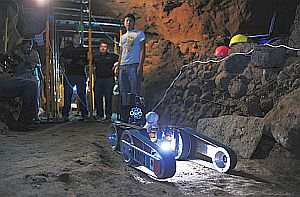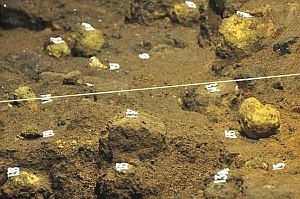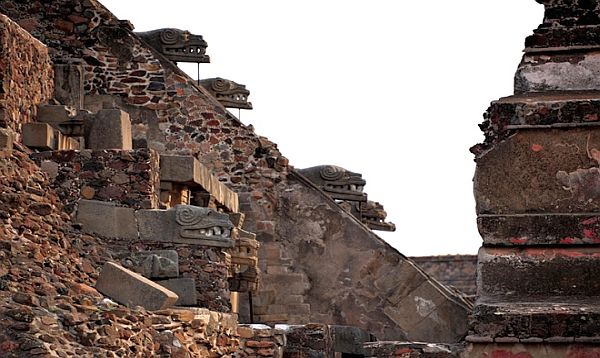San Juan Teotihuacán, Mexico - Hundreds of mysterious metallic-looking spheres lie beneath the Temple of the Feathered Serpent, an ancient six-level step pyramid just 30 miles from Mexico City.
The enigmatic spheres were found during an archaeological dig using a camera-equipped robot at one of the most important buildings in the pre-Hispanic city of Teotihuacan.
"They look like yellow spheres, but we do not know their origin or purpose. It's an unprecedented discovery," said Jorge Zavala, an archaeologist at Mexico's National Anthropology and History Institute.
 |
The Mesoamerican ruins of Teotihuacan, a World Heritage Site, represent one of the largest urban centers of the ancient world. Thought to have been established around 100 BC, the pyramid-filled city had more than 100,000 inhabitants at its peak, but was abandoned for mysterious reasons around 700 AD - long before the Aztecs arrived in the 1300's.
The excavation at the temple focused on a 330-foot-long tunnel which runs under the structure. The conduit was discovered in 2003 when heavy rain uncovered a hole a few feet from the pyramid.
Exploring the tunnel, which was deliberately sealed with debris and ruins by the Teotihuacan people, required several years of preliminary work and planning.
"Finally, a few months ago we found two side chambers at 236 and 242 feet from the entrance. We called them North Chamber and South Chamber," said archaeologist Sergio Gómez Chávez, director of the Tlalocan Project.
The archaeologists explored the tunnel with a remote-controlled robot called Tlaloc II-TC, which has an infrared camera and a laser scanner that generates 3D visualization of the spaces beneath the temple.
"The robot was able to enter in the part of the tunnel which has not yet been excavated yet and found three chambers between 328 and 360 feet from the entrance," Gómez Chávez said.
The mysterious spheres lay in both the north and south chambers. Ranging from 1.5 to 5 inches, the unexplained objects have a core of clay and are covered with a yellow material called jarosite.
This material is formed by the oxidation of pyrite, which is a metallic ore with a sparkling yellow coating, also known as "fools gold," Gómez Chávez said. "It means that in pre-hispanic times they appeared as if they were metallic spheres. There are hundreds of these in the south chamber."
 |
According to George Cowgill, professor emeritus at Arizona State University and the author of several publications on the Teotihuacan site, the spheres are a fascinating find.
"Pyrite was certainly used by the Teotihuacanos and other ancient Mesoamerican societies," Cowgill said. "Originally the spheres would have shown brilliantly. They are indeed unique, but I have no idea what they mean. They could have been offerings of some kind, as the temple was used by priests, but for now, no one can establish their function because it is an unprecedented discovery."
Even the walls and ceiling of both chambers were covered with a mineral powder composed of magnetite, pyrite, and hematite which provided a special brightness to the place. "We believe that high-ranking people, priests or even rulers, went down to the tunnel to perform rituals," Gómez Chávez said.
Indeed the archaeologists found many offerings, including pottery and wooden masks covered with inlaid rock crystal, jade, and quartz - all dating from around 100 AD.
Gómez Chávez and his team now look forward to the next phase of the project - exploring even deeper into the last part of the tunnel and the three chambers which archaeologists have seen through the robot cameras.
"The tunnel is in pristine condition, untouched for almost two millennia," said Ng “TC” Tze Chuen, an independent researcher who worked on the design of the Tláloc II-TC robot. "Can you can imagine what can be found inside?"
Ng, who helped create the Djedi robot that explored Egypt's Great Pyramid in 2010, believes the Mexican tunnel might lead to one of the most significant archaeological finds in Teotihuacan.
According to Gómez Chávez, the tunnel was sealed twice by the Teotihuacan people. Thick walls, erected to block access, were demolished about 1,800 years ago in order to deposit something very important in the central chamber at the end of the tunnel. "Maybe in this place," he said, "we will find the remains of those who ruled Teotihuacan.”


